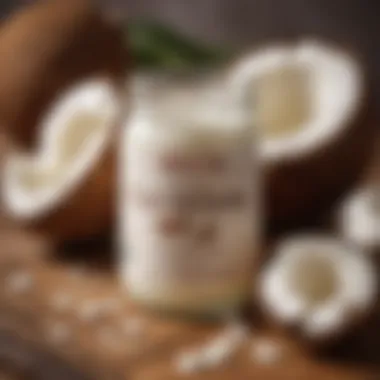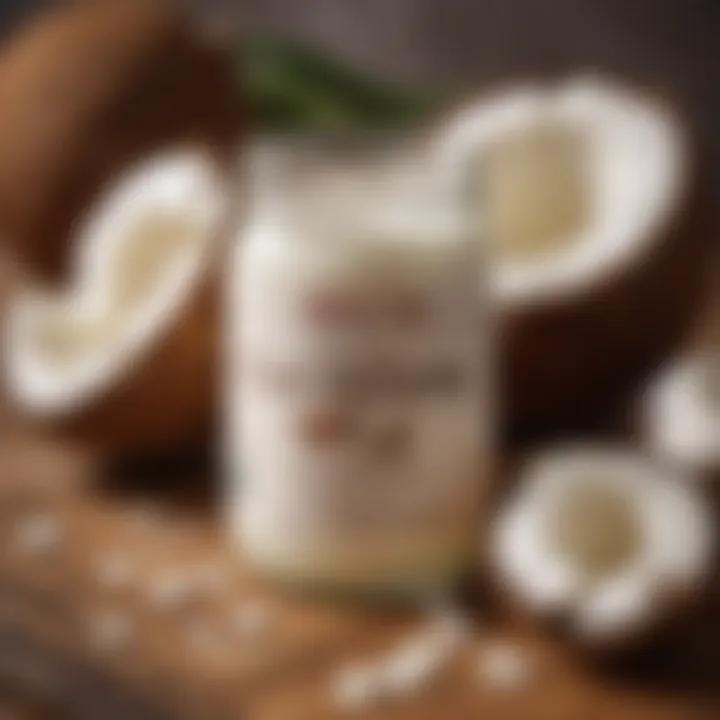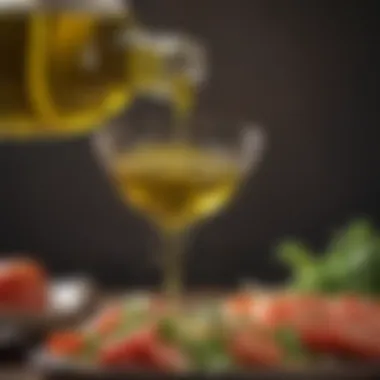Exploring Butter Substitutes: A Comprehensive Guide


Intro
The search for suitable butter substitutes has gained traction among home cooks and professional chefs alike. Traditional butter, while cherished for its rich flavor and unique texture, presents challenges related to dietary restrictions, health considerations, and changing culinary preferences. This guide aims to dissect the complexities of butter substitutes, highlighting the reasons for their increasing importance in contemporary cooking.
Butter plays a crucial role in various culinary applications, imparting flavor, moisture, and a pleasing mouthfeel to dishes. However, those with lactose intolerance, dairy allergies, or preference for plant-based diets often seek alternatives to enjoy similar gastronomic experiences.
"Understanding the reasons for substituting butter allows cooks to not only accommodate dietary needs but also explore innovative culinary possibilities."
In the sections to follow, we will delve into different butter alternatives, analyzing their characteristics and identifying the most effective uses of each substitute in cooking and baking. This exploration will cover a range of preferences, from vegan and lactose-free options to low-fat variants, ensuring that every cook can find a solution that fits their specific needs.
Preface to Butter and Its Role in Cooking
Butter holds a central position in culinary practices across various cultures. Its unique flavor and smooth texture enhance a multitude of dishes ranging from sweet pastries to savory meals. Moreover, the act of cooking with butter carries a weight of tradition, as it has been utilized for centuries. This extensive history makes butter not just an ingredient, but an integral component of cooking techniques that help create desired textures and flavors.
Understanding Butter
Butter is primarily a dairy product made by churning cream. It can be categorized into several types, including salted and unsalted varieties. Salted butter provides seasoning, which can influence the overall taste of a dish. Unsalted butter is generally preferred in baking because it allows for more precise control over the final salt content.
Butter is composed of about 80% fat, 16-18% water, and around 1-2% milk solids. This composition plays a significant role in how butter behaves in various cooking methods. For instance, the higher fat content contributes to moisture and richness in baked goods, while the water can create steam for leavening. Understanding these properties can guide cooks in achieving the desired results in their culinary endeavors.
Culinary Functions of Butter
Butter serves multiple culinary functions that go beyond simple flavor addition. It is instrumental in creating certain textures. In baked goods, it adds tenderness due to its fat content, making cookies chewy and cakes fluffy. When sautéing, butter can impart a rich depth of flavor to vegetables and meats, while also aiding in browning due to the Maillard reaction.
Additionally, butter acts as an emulsifier, helping to blend ingredients like oils with liquids. This property is crucial in sauces, such as hollandaise, where the silky texture is achieved through proper emulsification. The way butter interacts with other ingredients can significantly alter the dish's final outcome, proving its versatility in both savory and sweet preparations.
Understanding butter's fundamental role in cooking is essential for cooks. It gives insight into how to recreate traditional dishes or innovate with substitutes. As cooking practices evolve, recognizing the significance of butter prompts the exploration of alternatives that can still honor these culinary traditions while accommodating dietary needs.
Reasons to Consider Substitutes for Butter
The use of butter in cooking has long been embraced for its rich flavor and versatility. However, various factors can drive the need for alternatives. Understanding the reasons for considering butter substitutes is essential in today's culinary landscape. Each reason is a reflection of changing dietary habits, health considerations, and an interest in culinary innovation.
Dietary Restrictions and Allergies
Many people have specific dietary restrictions or allergies that limit their consumption of traditional butter. Lactose intolerance is one such condition, affecting a significant portion of the population. Individuals with this intolerance may experience digestive discomfort after consuming dairy products, including butter. In addition, some people may have outright allergies to dairy proteins, which can lead to severe reactions.
"Awareness of dietary restrictions is crucial in creating inclusive meals that cater to all individuals."
Choosing substitutes like coconut oil, which is lactose-free, allows these individuals to enjoy cooking without adverse effects. Similarly, people following vegan diets avoid all animal products, including butter. For them, plant-based oils or spreads may provide necessary functionality in recipes without sacrificing dietary principles.
Health Concerns
Apart from dietary restrictions, health issues are a primary consideration in the choice of butter substitutes. Traditional butter contains high levels of saturated fats, which have been linked to various heart-related issues. With rising awareness of cardiovascular health, many turn to healthier alternatives. Vegetable oils, for example, often contain healthier unsaturated fats and can benefit heart health. Many studies suggest that replacing saturated fats with unsaturated fats can promote better overall health.
Additionally, concerns regarding cholesterol levels have led to increased interest in plant-based options. Margarin and low-fat spreads often feature lower cholesterol content, making them a suitable substitute not just for health-conscious individuals but also for those managing specific health conditions.
Culinary Exploration
The culinary landscape is rapidly evolving, with chefs and home cooks alike constantly looking to broaden their horizons. Experimenting with butter substitutes offers a pathway to unique flavors and textures that enhance dishes in unexpected ways. Incorporating ingredients such as almond or peanut butter can introduce nuances into baked goods, transforming a standard cookie recipe into something distinctly new.
Moreover, using oils like olive or avocado oil can impart a more complex flavor profile, enriching the dish beyond what traditional butter offers. The exploration of these alternatives not only caters to individual dietary needs but also fosters creativity in cooking. By embracing diverse ingredients, cooks can expand their repertoire and discover new favorites that might otherwise have gone untested.
Popular Butter Substitutes
The exploration of popular butter substitutes is essential for anyone wanting to adapt their cooking to modern dietary needs. These substitutes are not merely alternatives; they can enhance flavor profiles, modify textures, and provide a range of nutritional benefits. Understanding various options allows cooks to create dishes that suit personal preferences and dietary requirements.
Vegetable Oils
Using vegetable oils is a common solution when substituting butter. These oils can be flexible and beneficial, depending on the type chosen. Each kind offers different flavors and characteristics.


Olive Oil
Olive oil is well-regarded for its rich flavor and health benefits. It is high in monounsaturated fats, which can promote heart health. Its key characteristic is its distinct taste, which can add depth to a variety of dishes. Many consider olive oil a beneficial choice due to its versatility in cooking and dressings. However, its strong flavor may not always suit sweet applications like baking.
Coconut Oil
Coconut oil is popular among those following certain diets, such as keto. It has a high smoke point, which means it's excellent for high-heat cooking. The unique feature of coconut oil is its solid form at room temperature, allowing it to serve similar physical functions as butter. It adds a slight sweetness to dishes, but it may not be the ideal choice in savory contexts due to its distinct taste.
Canola Oil
Canola oil stands out for its neutral flavor, making it a versatile option. It is low in saturated fat and high in omega-3 fatty acids, which can contribute positively to health. As a beneficial choice for frying and sautéing, it allows the other flavors of the dish to shine. However, some may criticize canola oil for being highly processed, which raises questions about its overall health impact.
Margarine
Margarine serves as a well-established substitute for butter. Made from vegetable oils, it usually has a similar texture and can be used in equal measure. Margarine has variations with added flavors or nutrients, appealing to many dietary preferences. One consideration is that it may not always have the same rich flavor that butter provides. When choosing margarine, inspecting the ingredient list is crucial, as some brands may use unhealthy trans fats.
Applesauce and Other Fruit Purees
Fruits like applesauce can replace butter, especially in baking. Using fruit puree reduces fat content while adding natural sweetness and moisture, which can enhance the texture of baked goods. Applesauce is often lower in calories and rich in fiber. Thus, it provides a healthier option. However, the apple flavor can be an important consideration, as it's not desirable in all recipes.
Nut Butters
Nut butters, such as almond butter and peanut butter, offer another interesting avenue for substitution. They each contain healthy fats and protein.
Almond Butter
Almond butter is a rich source of vitamins and minerals, making it a nutritional powerhouse. Its smooth texture and slightly sweet flavor can enhance baked goods. This nut butter also provides a wonderful alternative for those looking for a lactose-free option. One disadvantage is the cost, as almond butter can be pricier compared to other substitutes.
Peanut Butter
Peanut butter is a beloved alternative known for its creamy texture. It brings a nutty flavor that works well in various recipes. Its high protein content makes it a popular choice for health-conscious individuals. However, it's important to note that peanut butter can affect the overall flavor profile of dishes, so it's best suited for specific applications.
Yogurt and Sour Cream
Yogurt and sour cream provide excellent options that ensure moisture and creaminess in dishes. They can be lower in fat compared to butter while still enhancing flavor. They are particularly effective in baking and sauces, giving a tangy twist. However, yogurt and sour cream may not work well in certain baked goods that require fat for structural integrity.
Plant-Based Butters
Plant-based butters are crafted specifically for those seeking dairy alternatives. They are formulated to mimic the texture and taste of traditional butter. Such substitutes often contain a blend of various oils and may even include added vitamins. They are an attractive choice for vegans. Thus, they can meet many dietary restrictions. However, the quality of plant-based butters can vary significantly between brands, making careful selection essential.
Culinary Applications of Butter Substitutes
Understanding how butter substitutes apply in culinary contexts is crucial. Not only do these alternatives serve functional roles, they also influence taste and texture, enhancing the overall cooking experience. This section will discuss key areas where butter substitutes can be effectively integrated: baking, cooking, and spreads or toppings. Each application highlights specific features that may be beneficial, making them an essential focus for anyone experimenting with or catering to specific dietary needs.
Baking
When it comes to baking, substitutes can create unique characteristics in baked goods. Replacing butter in baked items affects both texture and flavor.
Texture Modifications
Texture is a pivotal aspect in baking, affecting how products rise and hold moisture. Butter typically contributes a tender and flaky result. Substitutes, however, can modify this texture in various ways. For instance, applesauce can impart moisture, creating a denser cake, whereas coconut oil offers a softer crumb. The key characteristic here is how each substitute interacts with other ingredients. The beneficial nature of these alternatives lies in their ability to introduce new textures that could appeal to various preferences. However, one must consider that some substitutes may require adjustments in liquid quantity to achieve desired outcomes during baking.
Flavor Adjustments
Flavor is equally vital in baked goods. Butter carries a rich, creamy taste, but substitutes can achieve different flavor profiles. For example, olive oil can add a fruity note to bread, while almond butter provides a nutty flavor in cookies. The unique feature of flavor adjustment is the ability to cater to different dietary restrictions while still enhancing taste. Nonetheless, using flavor-enhancing substitutes may alter the traditional taste expected in familiar recipes, which could be a disadvantage for those attached to classic flavors.
Cooking
Cooking with butter substitutes can elevate dishes beyond mere flavor and texture adjustments. Alternatives are versatile and can be utilized in various cooking methods, like sautéing and roasting.
Sautéing


Sautéing often requires fats that can withstand high heat. Although butter is a popular choice, substitutes like canola oil and ghee can also function well. The key characteristic of these alternatives is their higher smoke points, making them suitable for cooking at significant temperatures without burning. This is beneficial as it allows for crisping and browning of ingredients, creating desirable textures. However, the flavor can differ significantly from traditional butter, which some may find unappealing.
Roasting
Roasting is another area where substitutes can shine. Using olive oil or coconut oil can enhance flavors of vegetables, giving them a distinct aroma and taste. The unique feature of these oils is that they contribute their own flavor while also aiding in the caramelization of the food. This can be an advantage for those interested in adding a twist to roasted dishes. On the downside, not all substitutes will produce the same results as butter, particularly concerning the richness associated with roasted meats or hearty vegetables.
Spreads and Toppings
Spreads and toppings represent an essential way to incorporate butter substitutes in everyday meals. Products like plant-based butter or nut butters provide creamy alternatives that can be spread on bread or used in recipes.
They can retain the mouthfeel of butter, satisfying cravings without causing health concerns for those avoiding dairy. Furthermore, they can enhance the nutritional profile of meals, adding proteins or healthy fats. However, flavor distinctions are noticeable and can either appeal to or deter consumers.
The use of butter substitutes is not simply a matter of replacement; it invites culinary creativity, allowing for exploration within dietary frameworks.
In summary, understanding the specific applications of butter substitutes provides invaluable insight for cooks and food enthusiasts alike. Knowledge in this area can drive culinary innovation while adhering to dietary preferences.
Assessing the Nutritional Profiles
Understanding the nutritional profiles of butter substitutes is essential for making informed dietary choices. The impact of these substitutes extends beyond mere flavor. Each option brings its unique set of nutrients, which can significantly influence health outcomes and cooking results. The evaluation of nutritional contents allows cooks and consumers to select substitutes that meet both culinary expectations and health needs. Therefore, assessing caloric content and fat composition becomes key elements in this analysis.
Comparing Caloric Content
Caloric content is a crucial factor when choosing butter substitutes. Butter contains approximately 102 calories per tablespoon. This can vary among substitutes. For instance, olive oil delivers around 119 calories in the same serving size, while applesauce is notably lower at about 25 calories. The difference in calories can influence overall meal planning, especially for those watching their intake.
Selecting low-calorie options may help in weight management. On the other hand, higher-calorie substitutes may be beneficial in certain recipes that require richer flavors. Being aware of these details supports better decision making when it comes to health and flavor requirements. Here are the caloric values of some popular substitutes:
- Olive Oil: 119 calories per tablespoon
- Coconut Oil: 117 calories per tablespoon
- Margarine: Approximately 100 calories per tablespoon
- Applesauce: 25 calories per tablespoon
- Almond Butter: 98 calories per tablespoon
Fat Composition
Another vital consideration is fat composition. Different substitutes present varying types and amounts of fats. Butter consists mainly of saturated fats, which have been associated with increasing LDL cholesterol levels. In contrast, some substitutes, such as olive oil, contain predominantly monounsaturated fats, found to support heart health when consumed in moderation.
Understanding the distinctions in fat types helps inform dietary choices effectively. Here is an overview of common fats in popular substitutes:
- Saturated Fats: High levels in butter and certain margarines can raise cholesterol.
- Monounsaturated Fats: High in olive oil; beneficial for heart health.
- Polyunsaturated Fats: Found in canola oil; supports overall health, including omega-3 and omega-6 fatty acids.
When choosing a substitute, consider how its fat composition aligns with your dietary goals. Some individuals may seek lower saturated fats. Others may prefer options high in healthy fats for their potential health benefits. By analyzing these profiles, you can make choices that suit you better.
To summarize, evaluating the caloric content and fat composition is essential in making informed decisions about butter substitutes. These elements directly influence dietary health and culinary techniques.
Impact on Flavor and Texture
The impact on flavor and texture when substituting butter is crucial. Butter has a distinctive richness, adding depth and a creamy mouthfeel to dishes. When exploring alternatives, it is necessary to understand how substitutes can mimic this profile or introduce new ones. Flavor and texture influence how a dish is perceived. Thus, identifying suitable substitutes that maintain or even enhance overall palatability is key.
Using the right butter substitute can enhance dishes in unexpected ways. Some alternatives bring their unique flavors, which can complement ingredients in surprising manners. Others can shift texture—perhaps making things lighter or juicier, or providing a crisp finish. These transformations are essential to consider in recipe development and meal planning.
"Flavor is the most powerful memory trigger. It shapes our experiences at the dining table."
Flavor Profiles of Substitutes
Each butter substitute comes with its distinct flavor profile, which can greatly influence the final outcome of your dishes. Understanding these profiles allows for more thoughtful application.
- Vegetable Oils: While neutral in flavor, they can bring a subtle richness. Olive oil, for instance, can add a fruity note, while coconut oil offers a hint of sweetness.
- Margarine: Designed to mimic butter, its flavor can be close, though it typically lacks the depth of real butter. It does, however, hold its place in baking effectively.
- Nut Butters: Almond and peanut butters provide a nutty taste that can enhance baked goods or even savory dishes. They are not direct replacements but allow for creative applications.
- Applesauce: This alternative brings moisture and sweetness. It is ideal for baked goods where slight sweetness is welcome without the richness of butter.
The culinary landscape is diverse; thus, blending flavors can yield exciting results. Experimenting with different substitutes invites new taste experiences.
Changes in Texture
Texture is another significant factor in the quest for butter substitutes. Often, butter contributes to a desirable creaminess and a stable structure in recipes. When you replace it, the texture may alter in several ways.


- Baking: In baking, butter’s fat content is essential for achieving the right texture. Substitutes such as yogurt or plant-based butter may result in denser outcomes since they introduce more moisture.
- Cooking: When sautéing or roasting, using oils can create a crisp texture. The high smoke points of oils like canola mean better browning, which infuses more flavor into your dish.
- Spreads: For edible applications, nut butters provide a rich, creamy spread that mimics butter well but with added graininess.
Understanding these nuances helps in making informed choices when altering a recipe. Careful selection aids in maintaining, if not enhancing, the desired texture.
Vegan and Dairy-Free Options
The consideration of vegan and dairy-free options is increasingly significant in today's culinary landscape. As more individuals embrace plant-based diets for health, ethical, and environmental reasons, the demand for suitable substitutes for traditional ingredients, including butter, has grown. This section highlights suitable alternatives to butter that align with vegan and dairy-free diets, understanding their benefits and considerations.
Identifying Suitable Alternatives
When seeking vegan butter substitutes, it is crucial to identify options that meet both culinary and dietary needs. Several popular alternatives include:
- Coconut Oil: A versatile choice, coconut oil offers a rich flavor and varying textures based on its state (solid or liquid).
- Nut Butters: Almond butter or cashew butter can provide a creamy texture, ideal for baking and spreads.
- Avocado: Mashed avocado functions well in recipes that require moisture and healthy fats, adding nutritional value.
- Plant-Based Butters: Many brands now offer vegan butter made from various oils such as sunflower or olive, designed to mimic the flavor and consistency of dairy butter.
Each alternative presents unique characteristics that can affect flavor. Depending on the intended culinary use, some may work better than others.
Potential Adaptations in Recipes
Adapting recipes to accommodate vegan and dairy-free options is often straightforward. Here are some practical considerations:
- Adjust Measurements: When substituting, it may be necessary to alter amounts slightly, focusing on achieving the desired texture and flavor. For example, coconut oil may require less than the amount of butter.
- Baking Considerations: Since vegan substitutes can behave differently in baking, it is helpful to monitor baking times and temperatures. Liquid-form substitutes like coconut oil may yield different results than solid ones.
- Flavor Enhancements: Sometimes, the flavors of substitutes do not replicate traditional butter. Adding a touch of additional salt or a bit of lemon juice can enhance overall flavor profiles.
"Creating vegan adaptations not only meets dietary restrictions but also inspires culinary creativity."
Embracing vegan and dairy-free options allows for a broader array of dishes while also catering to the needs of various dietary preferences. Through thoughtful identification and adaptation, cooks can easily incorporate these substitutes into their kitchen repertoire.
Practical Tips for Substitution
Selecting the appropriate butter substitute requires careful consideration. Practical tips for substitution can significantly enhance your culinary experience. Factors such as flavor compatibility, nutritional profile, and moisture content play essential roles. Understanding these elements ensures successful dish preparation without compromising desired outcomes.
Measuring and Ratios
When substituting butter, accurate measurements are crucial. Each butter substitute has its unique ratio when replacing butter. A common guideline is to use a 1:1 ratio for similar fat content. However, for products like applesauce or yogurt, it is best to reduce the amount by about 25%. This adjustment accounts for the moisture content present in these replacements.
For example, if a recipe calls for one cup of butter, you might use three-quarters of a cup of applesauce. This alteration maintains the overall texture of your dish, avoiding an overly moist end result. Here are some suggested measuring guidelines:
- Vegetable Oils: Use a 1:1 ratio for standard cooking oils like olive oil.
- Margarine: Use a direct 1:1 replacement for butter.
- Nut Butters: They can replace butter using a 1:1 ratio, but be aware of the nutty flavor in your dish.
- Yogurt and Sour Cream: Typically, use ¾ cup for every cup of butter.
Remember: Adjusting measurements based on the unique properties of each substitute helps achieve the best results.
Choosing the Right Substitute for Your Dish
Determining the best butter substitute for your dish can alter the final outcome significantly. Consider the purpose of butter in the recipe. Is it for moisture, richness, or flavor? Each substitute carries its attributes.
- For Baking: Use margarine or coconut oil for similar textures. Applesauce works well in cakes for moisture but changes flavor slightly.
- For Sautéing: Olive oil is ideal for dishes that require quick cooking and a light, fresh flavor.
- For Spreads: Plant-based butters make excellent alternatives for spreading, mimicking butter’s creamy texture.
- For Rich dishes: Nut butters can add depth to recipes but think about the nutty flavor to blend with the overall dish's character.
Testing various substitutes in small batches allows you to discover how each affects flavor and texture. This exploration not only improves your cooking but can lead to delightful culinary surprises. Adjust as needed, and enjoy the process of finding the right fit for your culinary creations.
Finale
The conclusion of this article serves as a summation of key insights regarding butter substitutes. These substitutes are gaining recognition due to their growing importance in modern cooking. Understanding the alternatives to butter enables cooks to diversify their recipes and cater to various dietary needs.
Recap of Key Points
In summary, this article covered multiple aspects of butter substitutes:
- The fundamental purpose of butter in cooking and its essential characteristics.
- Reasons driving the need for butter alternatives, including health concerns, dietary restrictions, and culinary exploration.
- A range of suitable butter substitutes like vegetable oils, margarine, applesauce, nut butters, yogurt, and plant-based butters, with specific mentions of performance in different culinary applications.
- The nutritional profiles, including caloric content and fat composition, of these substitutes.
- The flavor and texture contributions that each substitute can provide to a dish.
- Special focus on vegan, dairy-free, and dietary options, providing clarity on how these fit into various dietary preferences.
- Practical suggestions for measuring and ratios when substituting butter in recipes.
Overall, the articulation of these points emphasizes the flexibility and adaptability of cooking with butter alternatives.
Encouragement to Experiment
The exploration of butter substitutes invites cooks to innovate and try new flavors and textures in their culinary endeavors. While some may stick strictly to traditional butter, there is much to gain from taking risks with alternatives. Experimentation can reveal unexpected yet delightful results, enhancing the taste and healthiness of dishes.
Utilizing substitutes opens new doors for creativity in meal preparation. Whether one seeks to cater to health concerns or merely broaden their culinary horizons, it is crucial to embrace this adaptability in cooking. The journey may yield new favorite recipes and perhaps, a fresh take on familiar ones.
This guide encourages readers to delve deeper into these substitutes, discover what works best, and share their culinary outcomes. Each cooking experience stands as an opportunity to refine one's skills while observing how different ingredients interact. Such experimentation is key to mastering the art of cooking.







